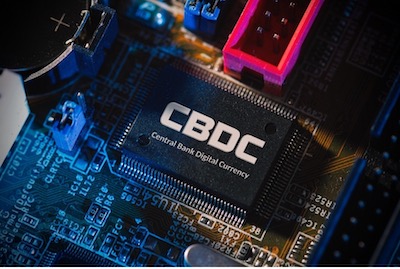Can, and Should, the U.S. Government Develop a CBDC System?
By James Holbein, Braumiller Law Group PLLC
In response to the Executive Order on Ensuring Responsible Development of Digital Assets[1] issued on March 9, 2022, both the White House Office of Science and Technology Policy (OSTP) and the Treasury Department (Treasury) have recently issued reports analyzing the possible design and feasibility of creating a U.S. Central Bank Digital Currency (CBDC).[2] The reports make clear that significant technical issues and major policy considerations need to be addressed for the U.S. to develop a CBDC. Both reports look at time frames in years, not weeks or months, for such a system. The time frame is not entirely surprising, given that the government must move cautiously when taking any action that could impact the currency.[3] The U.S. dollar is widely considered the reserve currency for the global economy, as well as the trusted medium of exchange for the U.S., so changes could impact the economy severely if not handled well. This article is intended to summarize the findings and recommendations of the two reports cited above and provide some insight into the likelihood and timing for the development of a U.S. CBDC system.
Technical Evaluation for a U.S. Central Bank Digital Currency System
The OSTP report focuses on the risks and benefits of a CBDC system by evaluating the technical design choices and goes into some detail on the multiple, interrelated possibilities for building a CBDC system. It looks at possible Minimal Viable Products (MVPs) based on hypothetical design choices and their impact on existing federal processes. The OSTP report concludes with recommendations on how to prepare the federal government for implementation of a CBDC system. The authors very carefully disclaimed making any recommendations or assessments about whether a CBDC system should be pursued.
The objectives of the Executive Order guided the evaluation. These are that a CBDC system should: provide benefits and mitigate risks for consumers, investors, and businesses; promote economic growth and financial stability and mitigate systemic risk; improve payment systems; ensure the global financial system has transparency, connectivity and platform and architecture interoperability or transferability; advance financial inclusion and equity; protect national security including compliance with existing anti-money laundering and counter-terrorism requirements; provide the ability to exercise human rights; and align with democratic and environmental values, including privacy protections. That is quite a list of conflicting objectives that does not lend itself readily to a set of requirements for building a new IT system.
Intermediation – The technical evaluators looked at many different choices that will need to be considered in the design of a new CBDC system. The role of intermediation in the current banking system is played primarily by the Federal Reserve and commercial banks. In a CBDC system, the evaluators provide a list of functionalities to be analyzed, including, but hardly limited to the following:
- issuing currency,
- distributing currency,
- custody and wallets for currency,
- validating transactions,
- settling transactions,
- provisioning access (e.g., user accounts, know your customer),
- providing user interfaces,
- providing customer service,
- conducting fraud detection,
- conducting AML/CFT compliance, and
- resolving disputes.[4]
The wide range of possible intermediaries from the existing system to include private entities or even no intermediaries indicated that the choices available are neither simple nor trivial. The Federal Reserve made clear in a separate analysis that, “a potential U.S. CBDC, if one were created, would best serve the needs of the United States by being privacy-protected, intermediated, widely transferable, and identity-verified.”[5] Given the high degree of centralization of the current system, any CBDC system will be based on centralized intermediation so that the digital and paper currency can be managed to achieve central government goals and purposes.
Interoperability – How would a CBDC payment system be interoperable with the existing central bank and commercial bank payment systems, as well as international payment systems? Note that “ interoperability is not the same as integration, as the former refers to systems that can talk to each other, while the latter refers to more direct access to other systems.”[6]
Permissions – The evaluation team reviewed the merits of a permissioned, as opposed to a permission-less system. I would again conclude that any CBDC system would have as a starting point the permissioned approach currently required by U.S. law and regulations.
Access Tiers – A more interesting question is posed by whether a CBDC system could be tiered, with a high level of intermediation, permissions and access for the existing banks and related entities dealing directly with the Federal Reserve on a higher level of access and security than those entities dealing with commercial banks or other potential intermediaries. Access by mobile phone for the underbanked would be a different tier than that for companies and larger enterprises managing large volumes of transactions with higher values.
Identity Privacy – A huge issue for the digital asset community will be the level of privacy afforded to users. Higher tier users, for example, would be required to be known by the central bank, while the lowest tier users would be afforded much more privacy.
Remediation – How to handle mistakes, such as chargebacks and disputed charges, or legal actions such as liens and related remedial measures, raises important questions of functionality. The evaluators stated that, “remediation would likely be easiest to implement in a permissioned and centralized CBDC system with intermediaries that have visibility onto a ledger and the ability to submit transactions.”[7] Existing systems for dealing with these issues would heavily influence the design and implementation of a new system to ensure that it would not be disruptive.
Security – Absolutely critical to the acceptance and usability of a new system will be maintaining a high level of security. The report discussed cryptography, as one would expect for digital assets, all of which are based on cryptography for the existence and use. Additionally, the evaluators also looked at hardware and software security for the interfaces with the system.
Transaction Functionality – Transactions are at the heart of any payment system, so the evaluation analyzes how to deal with signatures (none, single or multiple signatures), privacy of transactions, whether transactions could be online or offline, and whether transaction programmability, such as smart contracts, should be enabled. Given the blockchain and distributed ledger technologies at the heart of private cryptocurrencies, these questions will have major implications for how the system can or should enable transactions. Unanswered questions remain as to how a potential CBDC could integrate with current public blockchains and their native cryptocurrencies.
Data – How transactions are to be recorded and what type of ledger (centralized or distributed) are fundamental for use of digital assets that rely on smart contracts and blockchain. So, the answers are again important and complex for the overall design of a new CBDC system. If there is tiered access, then limits on the number of transactions and how much an account can hold are very likely to be imposed. Will a system support both fungible units and non-fungible (NFTS)? Will accounts pay interest, will adjustments be possible for balances, can fees be charged, and other related functional questions will certainly drive design as well as influence acceptance of a CBDC by the existing digital assets community.
Minimum Viable Product (MVP) – With the background of the multiple choices and options that will influence the development of a new CBDC system, the evaluators made three regarding the feasibility of developing an MVP, “(1) a set that is minimally complex, (2) a set that is more complex focused on broader participation, and (3) a set that is more complex focused on programmability, privacy, and inclusion.”[8] The scenarios assumed systems that provide the minimal set of features needed to solve a specific set of problems, but is not a fully-functional “CBDC pilot” that could directly evolve into a real CBDC.
Impact of a U.S. CBDC System on Federal Processes – One of the most important constraints on the development of a new CBDC system is its probable impact on existing systems and legacy software. The evaluators looked at issues involving cybersecurity and privacy, likely expectations for user experiences, and social safety net programs such as Medicare, Medicaid, Social Security, Supplemental Nutrition Assistance Program benefits, and unemployment insurance, to assess the impact of a potentially disruptive technology.
Recommendations and Comments – Given the complexity of the evaluation factors, it is not surprising that the evaluation recommendations were supportive of taking a long time to do research and experimentation within the Federal Reserve in coordination with a CBDC Working Group of concerned agencies. The evaluators recommend using existing organizations with the U.S. government to establish a digital assets R&D agenda and recommend funding and investment from multiple agencies. Finally, the report recommends scaling up technical capacity across the federal government. That allocation of resources would, of course, need to be authorized by Congress, requiring new legislation and amended budgets, a problematic proposition for any initiative. Given the decades it took to develop a single window for trade and the multiple legacy computing systems for payments that rely on decades-old software backbones that have become almost irreplaceable, the likelihood of a new payments system rapidly replacing existing systems is virtually nil, in the opinion of this former federal executive.
The Future of Money and Payments
This report from the Treasury Department provides an overview of money and payment systems and is useful to put the development of a CBDC system into perspective. It defines money and elaborates in some detail about each of the core functions. “Money serves three core functions: a unit of account, a medium of exchange, and a store of value. It can be public money—primarily a liability of the central bank—or private money—a liability of a private intermediary.”[9]
Similarly, the overview of payment systems is helpful to place the discussion in context. “Payment systems transfer money. Consumers and businesses use retail payment systems for transactions that typically involve smaller dollar amounts; banks and other financial institutions use wholesale payment systems that generally involve larger dollar amounts.” [10]
Much of the text repeats and elaborates on the design choices in the CBDC Evaluation for development of a CBDC system outlined above. The key recommendations are also similar to those in the CBDC report, as follows:
Recommendation 1: Advance work on a possible U.S. CBDC, in case one is determined to be in the national interest. A U.S. CBDC has the potential to offer significant benefits, but further research and development on the technology that would support a U.S. CBDC is needed and could take years.[11]
Recommendation 2: Encourage use of instant payment systems to support a more competitive, efficient, and inclusive U.S. payment landscape. New instant payment systems have been recently developed or are scheduled to launch soon, capable of handling higher volumes of transactions at lower cost than some current payment systems.[12]
Recommendation 3: Establish a federal framework for payments regulation to protect users and the financial system, while supporting responsible innovations in payments. Treasury recommends consideration of the establishment of a federal framework for nonbank payment providers that would complement existing federal requirements, including for consumer protection and AML/CFT.[13]
Recommendation 4: Prioritize efforts to improve cross-border payments. Private sector payment innovations have been driven in part by inefficiencies in the current cross-border payment systems. To respond to these inefficiencies, countries are making efforts to enhance cross-border payments, both through improvements to existing systems and with forward-looking work that leverages new technologies. The United States also has a strong national interest in being at the forefront of technological development and supporting global standards for cross-border payment systems that reflect U.S. values, including privacy and human rights that are consistent with AML/CFT considerations; and protecting U.S. national security.[14]
Summary and Conclusions
Is a CBDC Needed? Based on my analysis of these advisory reports, I come away with several questions that I do not believe have been adequately evaluated or analyzed yet. The fundamental question is whether a CBDC is necessary at all? Both agencies stress the need for much more study, research, analysis, testing, and cooperation. This is the standard government approach to responding to problems, and may yield results, but not for several years to come. The digital assets sector is moving and evolving at a pace the government simply cannot equal. When many agencies are running software from the 1980s and earlier as backbone technologies, how can they possibly innovate at the pace of the private sector? They simply cannot, unless vastly larger amounts of money, time, personnel and cooperative public-private partnerships are brought to bear. Unless the government can move faster, the time for developing and implementing a CBDC system will simply pass without anything being accomplished. I am not advocating rushing willy-nilly into such a system, but I do not think a CBDC system deliverable in 10 years will meet the needs of that time.
What about counterfeiting? I have not seen any analysis about that fundamental issue. If a bad actor can hack into a CBDC system and copy the code or payment system protocols of an intermediary, will there be a danger of a non-official CBDC being created and distributed without the knowledge of the regulatory and security authorities? Given the massive breach of OPM records several years ago in which my personal data was taken, I am not particularly confident that a CBDC will not become inflationary through unauthorized copying and distribution. This is simply a recognition of the high level of physical security surrounding fiat currency and the high level of effort needed to protect the banking system from unauthorized intrusions.
Unbanked and underbanked. Cannot unbanked citizens more easily be allowed access to the existing banking system with simpler means to open accounts, use smart phones, and get access to the payments and remittances system through commercial banks on a free basis simply to ensure that the commercial banks can stay in business? It would make far more sense to enable any citizen to participate in the existing banking system on a concessional or federally subsidized basis than to develop an entirely new digital system that will take years to work properly.
Private cryptocurrency. If a CBDC is developed, how will regulatory and banking authorities deal with private cryptocurrency? Based upon my own research into private money, a CBDC would crowd out private cryptocurrencies just as scrip and many other experiments with currency to meet the needs of companies and citizens underserved by the banking and payments systems. The rapid development of cryptocurrencies into a several trillion-dollar market indicates that they meet a need that existing currency and systems are inadequate to address.
Distrust of the banking system. Following the Great Recession of 2008, there is a residual distrust of the central bank, commercial banks and fiat currency among many citizens. There is also a recognition that there is no profitable way to store money in the banking system without its value inflating away the longer it stays in accounts. Digital assets have many of the characteristics of money and they are easier to transact with in some use cases. The anonymity of the blockchain enabled systems help limit government intrusion into citizens’ and companies’ records. However, the need for prudential tools like AML/CFT and KYC rules requires anonymity to be sacrificed, which is a major barrier to acceptance of a CBDC system for existing users of cryptocurrencies. How can that be balanced in a new CBDC system that will almost certainly be centralized with few intermediaries (likely to be commercial banks), tiered access with disclosure of individual information, and permissioned access? I believe that the government will have a major problem with building a system that users of existing blockchain technology will accept.
In sum, it is my opinion that the government will likely fund studies and work hard to innovate and perhaps legislate a CBDC system, but the length of time needed to succeed is likely to be too long to be successfully achieved. That said, there are several measures that can be developed now using existing digital payment approaches to provide many of the benefits of a CBDC system without the enormous effort to launch a wholly new currency.
[1]https://www.whitehouse.gov/briefing-room/presidential-actions/2022/03/09/executive-order-on-ensuring-responsible-development-of-digital-assets/
[2] Technical Evaluation for a U.S. Central Bank Digital Currency System, (CBDC Evaluation) White House Office of Science and Technology Policy, September 2022, https://www.whitehouse.gov/wp-content/uploads/2022/09/09-2022-Technical-Evaluation-US-CBDC-System.pdf; The Future of Money and Payments, Department of Treasury, September 2022, https://home.treasury.gov/system/files/136/Future-of-Money-and-Payments.pdf.
[3] The Executive Order resulted in a number of other reports that are beyond the scope of this article. They have to do with, among other things, how to regulate the illicit criminal activity that has characterized much of the digital assets sector over the past decade. Analysis of those reports will be the subject of another article.
[4] CBDC Evaluation, fn. 9, p. 12
[5] Money and Payments: The U.S. Dollar in the Age of Digital Transformation, Board of Governors of the Federal Reserve System, January 2022, https://www.federalreserve.gov/publications/january-2022-cbdc.htm.
[6] CBDC Evaluation, p. 15.
[7] Ibid., p. 23.
[8] Ibid., p. 42.
[9] The Future of Money and Payments, p. 1.
[10] Ibid.
[11] Ibid., p. 45.
[12] Ibid., p. 46.
[13] Ibid., p. 47.
[14] Ibid., p. 48.
Read more articles by this author: https://www.braumillerlaw.com/author/james-holbein/



























